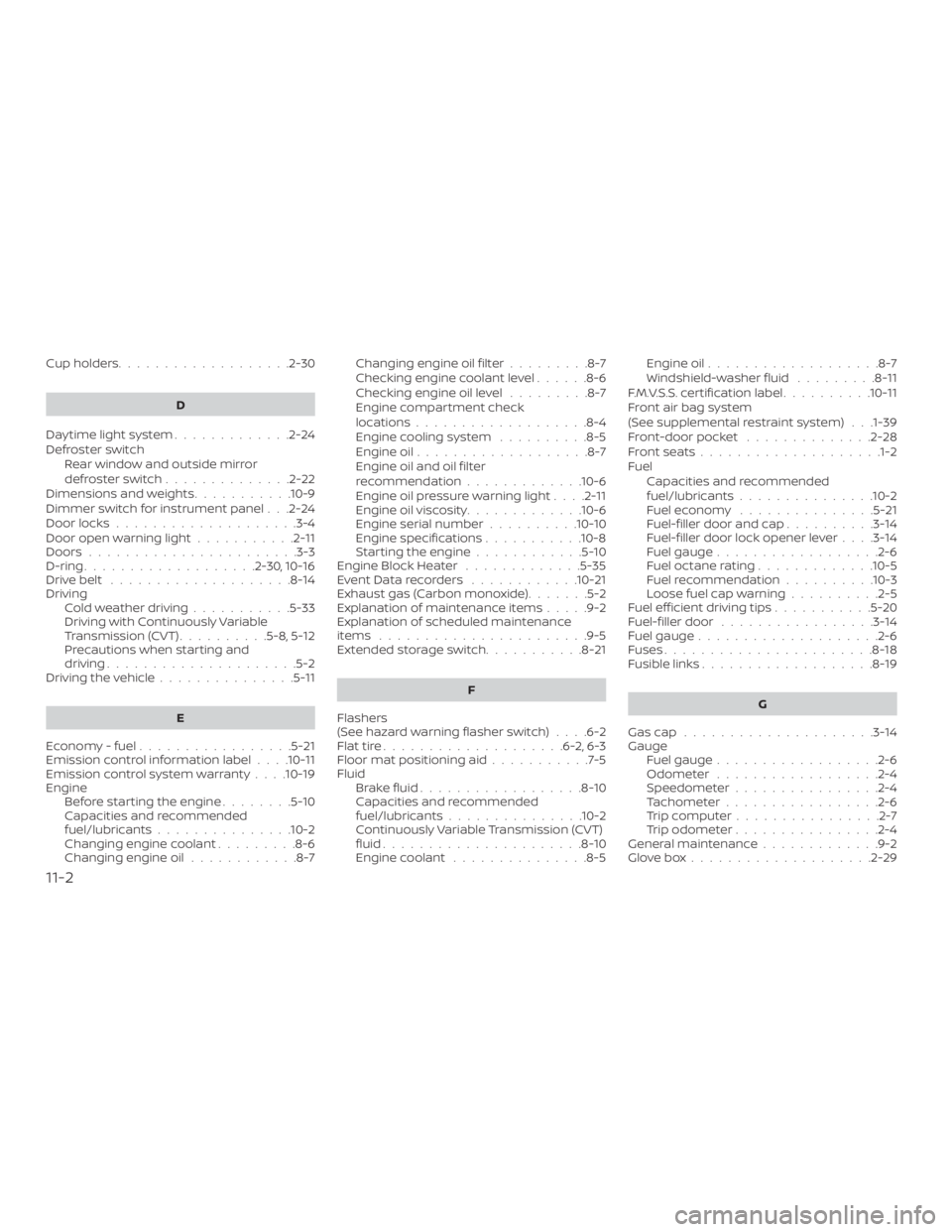Page 185 of 300
∙ Do not use the cruise control (if soequipped) on slippery roads.
∙ Snow can trap dangerous exhaust gases under your vehicle. Keep snow
clear of the exhaust pipe and from
around your vehicle.
ENGINE BLOCK HEATER (if so
equipped)
Engine block heaters are used to assist
with cold temperature starting.
The engine block heater should be used
when the outside temperature is 20°F (-7°C)
or lower.
Page 190 of 300
A. Blocks
B. Flat tire
Blocking wheels
Place suitable blocks at both the front and
back of the wheel diagonally opposite the
flat tire to prevent the vehicle from moving
when it is jacked up.
Page 192 of 300
7. Open the back door.
8. Loosen the bolt
�1counterclockwise
approximately 40 turns to lower the
spare. Be careful not to excessively
loosen the bolt because the basket
may fall abruptly. 9. Stop turning the bolt when the spare is
lowered to the point where the tire bas-
ket
�2can be removed from the hook
�3.
10. Remove the wheel basket by pushing the basket upward.
11. Lower the tire basket to the ground and take out the spare.
12. Reverse steps 8–11 to return the basket to its position under the vehicle.
Spare wheel basket bolt tightening
torque:
20 f t-lb (27 N-m)
Removing wheel cover (if so
equipped)
Page 219 of 300
Engine oil and filter
1. Place a large drain pan under the drainplug and oil filter.
2. Remove the oil filler cap.
3. Remove the drain plug with a wrench by turning it counterclockwise and
completely drain the oil.
Page 224 of 300
The current sensor�Ais located near the
battery along the negative battery cable. If
you add electrical accessories to your ve-
hicle, be sure to ground them to a suitable
body ground such as the frame or engine
block area.
1. Automatic tensioner pulley
2. Generator pulley
3. Water pump pulley
4. Air conditioner compressor pulley
5. Crankshaf t pulley
Page 231 of 300
Extended storage switch
If any electrical equipment does not oper-
ate, remove the extended storage switch
and check for an open fuse.
NOTE:
The extended storage switch is used for
long term vehicle storage. Even if the ex-
tended storage switch is broken it is not
necessary to replace it. Replace only the
open fuse in the switch with a new fuse.How to replace the extended storage
switch:
1. To remove the extended storage switch, be sure the ignition switch is in
the OFF or LOCK position.
2. Be sure the headlight switch is in the OFF position.
3. Remove the fuse box cover.
4. Pinch the locking tabs
�1and�2found
on each side of the storage switch.
5. Pull the storage switch straight out from the fuse box
�3.
Page 234 of 300
Replacing the halogen headlight
bulb
Disconnect the negative battery cable be-
fore replacement and installation of the
headlight bulb.
�1Release the clip on the connector.
�2Rotate the bulb counterclockwise and
pull out to remove. Replace as neces-
sary.
Page 290 of 300

Cupholders...................2-30D
Daytime light system .............2-24
Defroster switch Rear window and outside mirror
defrosterswitch..............2-22
Dimensions and weights ...........10-9
Dimmer switch for instrument panel . . .2-24
Door locks ....................3-4
Door open warning light ...........2-11
Doors .......................3-3
D-ring ...................2-30,10-16
Drivebelt ....................8-14
Driving Coldweatherdriving...........5-33
Driving with Continuously Variable
Transmission (CVT) ..........5-8,5-12
Precautions when starting and
driving .....................5-2
Drivingthevehicle...............5-11
E
Economy - fuel .................5-21
Emission control information label . . . .10-11
Emission control system warranty . . . .10-19
Engine Before starting the engine ........5-10
Capacities and recommended
fuel/lubricants...............10-2
Changing engine coolant .........8-6
Changing engine oil ............8-7 Changing engine oil filter
.........8-7
Checking engine coolant level ......8-6
Checking engine oil level .........8-7
Engine compartment check
locations...................8-4
Engine cooling system ..........8-5
Engine oil ...................8-7
Engine oil and oil filter
recommendation .............10-6
Engine oil pressure warning light ....2-11
Engine oil viscosity .............10-6
Engine serial number ..........10-10
Engine specifications ...........10-8
Starting the engine ............5-10
Engine Block Heater .............5-35
EventDatarecorders ............10-21
Exhaust gas (Carbon monoxide) .......5-2
Explanation of maintenance items .....9-2
Explanation of scheduled maintenance
items .......................9-5
Extended storage switch ...........8-21
F
Flashers
(See hazard warning flasher switch) ....6-2
Flattire....................6-2,6-3
Floormatpositioningaid...........7-5
Fluid Brakefluid..................8-10
Capacities and recommended
fuel/lubricants...............10-2
Continuously Variable Transmission (CVT)
fluid......................8-10
Engine coolant ...............8-5 Engine oil
...................8-7
Windshield-washer fluid .........8-11
F.M.V.S.S. certification label ..........10-11
Front air bag system
(See supplemental restraint system) . . .1-39
Front-door pocket ..............2-28
Frontseats....................1-2
Fuel Capacities and recommended
fuel/lubricants...............10-2
Fuel economy ...............5-21
Fuel-filler door and cap ..........3-14
Fuel-filler door lock opener lever . . . .3-14
Fuel gauge ..................2-6
Fueloctanerating.............10-5
Fuel recommendation ..........10-3
Loosefuelcapwarning..........2-5
Fuel efficient driving tips ...........5-20
Fuel-filler door .................3-14
F
uel gauge ....................2-6
Fuses .......................8-18
Fusiblelinks...................8-19
G
Gascap .....................3-14
Gauge Fuel gauge ..................2-6
Odometer ..................2-4
Speedometer ................2-4
Tachometer .................2-6
Trip computer ................2-7
Trip odometer ................2-4
General maintenance .............9-2
Glovebox....................2-29
11-2